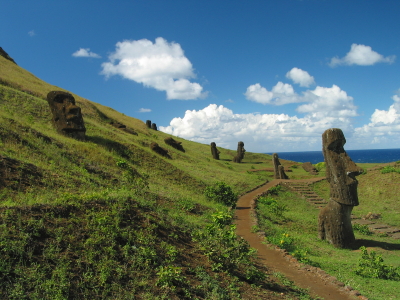Chile, officially the Republic of Chile (Spanish: República de Chile (help·info)), is a country in South America occupying a long and narrow coastal strip wedged between the Andes mountains and the Pacific Ocean. It borders Peru to the north, Bolivia to the northeast, Argentina to the east, and the Drake Passage at the country’s southernmost tip. The Pacific forms the country’s entire western border, with a coastline that stretches over 6,435 kilometres.[4] Chilean territory extends to the Pacific Ocean which includes the overseas territories of Juan Fernández Islands, the Sala y Gómez islands, the Desventuradas Islands and Easter Island located in Polynesia. Chile claims 1,250,000 km² (482,628 sq mi) of territory in Antarctica.
Chile’s unusual, ribbon-like shape —4,300 km long and on average 175 km wide— has given it a hugely varied climate, ranging from the world’s driest desert – the Atacama – in the north, through a Mediterranean climate in the centre, to a snow-prone Alpine climate in the south, with glaciers, fjords and lakes.[5] The northern Chilean desert contains great mineral wealth, principally copper. The relatively small central area dominates the country in terms of population and agricultural resources. This area also is the cultural and political center from which Chile expanded in the late 19th century, when it incorporated its northern and southern regions. Southern Chile is rich in forests and grazing lands and features a string of volcanoes and lakes. The southern coast is a labyrinth of fjords, inlets, canals, twisting peninsulas, and islands. The Andes Mountains are located on the eastern border.[6]
Prior to the coming of the Spanish in the 16th century, northern Chile was under Inca rule while Araucanian Indians (also known as Mapuches) inhabited central and southern Chile. Although Chile declared its independence in 1810, decisive victory over the Spanish was not achieved until 1818. In the War of the Pacific (1879-83), Chile defeated Peru and Bolivia and won its present northern regions. It was not until the 1880s that the Araucanian Indians were completely subjugated.[7] The country, which had been relatively free of the coups and arbitrary governments that blighted the South American continent, endured a 17 year military dictatorship (1973-1990), one of the bloodiest in 20th-century Latin America that left more than 3,000 people dead and missing.[5]
Currently, Chile is one of South America’s most stable and prosperous nations.[5] Within the greater Latin American context it leads in terms of competitiveness,[8][9][10][11] quality of life,[12] political stability,[13] globalization,[14] economic freedom,[15][16][17][18] low corruption perception[19] and comparatively low poverty rates.[20][21][22] It also ranks high regionally in freedom of the press,[23][24] human development[25] and democratic development.[26] Its status as the region’s richest country in terms of gross domestic product per capita (at market prices[27] and purchasing power parity[28]) is countered by its high level of income inequality, as measured by the Gini index.
Filed under: Blogging, Chile, Culture, Guide, Nature, Photo, Photography, Photos, Pictures, Travel, Trip, Vacation | Leave a comment »





 Llullaillaco National Park is a national park of Chile, located 275 km southeast of Antofagasta in the Andes. It lies between the eastern slopes of the Cordillera Domeyko and the international border with Argentina. In the park there are several important mountains that culminate at the summit of Llullaillaco volcano. The park also is characterized by extensive semi-desert plains interspersed by Quebradas. A
Llullaillaco National Park is a national park of Chile, located 275 km southeast of Antofagasta in the Andes. It lies between the eastern slopes of the Cordillera Domeyko and the international border with Argentina. In the park there are several important mountains that culminate at the summit of Llullaillaco volcano. The park also is characterized by extensive semi-desert plains interspersed by Quebradas. A 